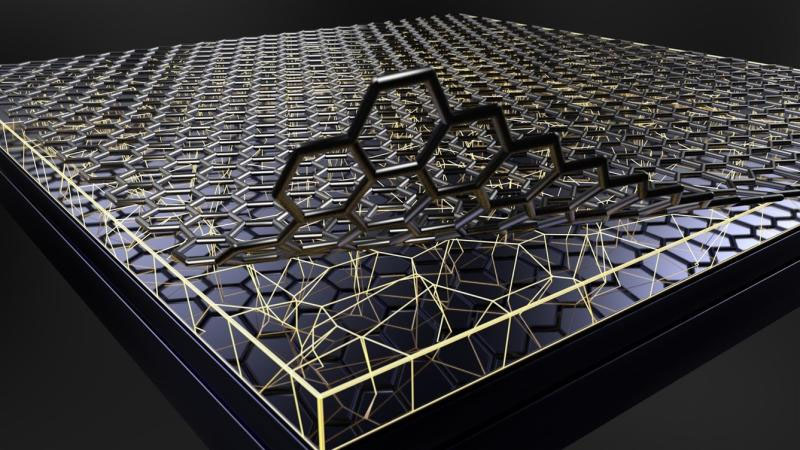| Jan 15, 2024 |
Breakthrough method enables scalable hexagonal boron nitride synthesis for superior corrosion protection
(Nanowerk News) Industrial metals face an unrelenting threat from corrosion and degradation that drains trillions annually. Yet effective large-scale protection has remained elusive, frustrating both structural engineers and asset managers alike. Advanced coatings once seemed poised to deliver a breakthrough after graphene isolation enabled investigation of other 2D films. The layered boron nitride (hBN) emerged as especially promising given its chemical inertia and thermal stability similar to its carbon counterpart.
|
|
However, inconsistent quality, complexity and poor yield have hindered adoption outside academic labs. Synthesizing uniform hBN on metals at production volumes has proven extraordinarily challenging.
|
|
Researchers at Oak Ridge National Laboratory have now unveiled a remarkably simple and eminently scalable approach to deposit high quality hBN onto commercially essential iron and nickel alloys. Simply by catalyzing inert dinitrogen on suitable substrates, they govern film growth with unprecedented control.
|
|
This capability promises to unlock corrosion prevention and friction reduction for enormous industries dependent on ubiquitous steels and superalloys. The technique could soon enjoy widespread implementation at coatings manufacturers, enabling immediate efficiency gains for infrastructure, transportation, marine systems and beyond.
|
|
The findings have been published in Advanced Materials Interfaces ("Armor for Steel: Facile Synthesis of Hexagonal Boron Nitride Films on Various Substrates").
|
 |
| Scientists applied a simple approach for growing hBN films on the surface of ubiquitous steels and other metal alloys to “armor” them and thus increase their capabilities. (Image: Adam Malin, ORNL)
|
|
Corrosion affects structures across transportation, infrastructure, marine systems and more, causing trillions in economic damage annually. For essential alloys containing iron or nickel, oxidation and chemical degradation impede durability and drive costly maintenance. Research into advanced coatings has accelerated in recent years with the isolation of graphene and subsequent discovery of other 2D materials. As an ultra-wide bandgap insulator analogous to graphene, layered hBN shows exceptional chemical inertness, thermal and mechanical stability. Early studies found hBN layers shielded metals from oxidation and friction. However, existing production techniques struggled with consistency, yield and scale.
|
|
The most common hBN synthesis has involved hazardous precursors like borazine and explosive ammonia borane. Controlling uniform precursor decomposition in a large reactor is decidedly non-trivial. Alternate attempts using diborane and ammonia resulted in uncontrolled nanoparticle formation rather than quality hBN films. The field has thus focused on specialized lab-scale processes unsuitable for real-world applications.
|
|
"Enormous industrial sectors rely on abundant and benign precursors amenable to safe, reproducible large-area deposition,” said principal investigator Dr Ivan Vlassiouk. “We aimed to develop an atmospheric pressure approach for high-volume hBN manufacturing.”
|
|
Now, the team demonstrates high quality hBN can be grown at industrial scales simply using dinitrogen and unreactive boron sources. Scientists leveraged the analogy between hBN synthesis and the catalyzed Haber process for mass ammonia production. In that Nobel prize-winning method, dinitrogen activation on specific surfaces controls reaction kinetics rather than precursor concentrations. Researchers hypothesized similar rate limitation on catalytic dissociative nitrogen adsorption would enable unprecedented process control.
|
|
By judiciously selecting substrates and conditions, they facilitated selective hBN deposition across centimeter-sized regions. Unreacted dinitrogen ensured uniform film quality independent of reactor geometry. The team systematically optimized each parameter from temperature to catalyst composition. Notably, adding iron to nickel accelerated growth but often trapped excess nitrogen as defects. Pure nickel yielded superior monolayer hBN with basal planes extending 500 micrometers. Such wafer-scale single crystals outperform exfoliated flakes for next-generation electronics. For the first time, hBN was deposited on real-world steels and nickel alloys without pretreatment. Raman spectroscopy indicated complete surface coverage even on intricate samples.
|
|
Raman spectroscopy indicated complete surface coverage even on intricate samples. Based on relative spectral intensities, researchers assessed thicker hBN formation on stainless steel compared to mild steel. They attribute this difference to enhanced nitrogen dissolution and subsequent hBN precipitation in the presence of chromium. Under regular synthesis conditions, mild steel samples 0.75-3 mm thick were coated with films around 100 nm thick after 1 hour.
|
|
Ten-day exposure to concentrated hydrochloric acid showed 7X reduction in dissolution. Furthermore, hBN coating maintained structural integrity up to 850 °C in air where unprotected steel degrades within minutes. Researchers also measured a 10X friction decrease consistent with other 2D lubricants like graphene. Ongoing optimization will improve longevity for harsh environments. Nonetheless, implemented today this technique immediately enables inexpensive hBN integration where it was previously unattainable.
|
|
Dr Vlassiouk concluded, “Using only dinitrogen and boron, our CVD synthesis has achieved large-area hBN deposition on the industrially preferred metals iron and nickel. Governing hBN quality by surface catalysis of inert precursors solves the bottleneck for real-world adoption across corrosion prevention, high temperature shielding and lowered friction. With exceptional scalability and trivial safety considerations, we fully expect rapid commercialization by coating suppliers." This pioneering development epitomizes the potential of leveraging fundamental chemical understanding to Engineer game-changing solutions for longstanding technological barriers. Many industries now have a simple path to substantial efficiency gains through hexagonal boron nitride surface protection.
|

